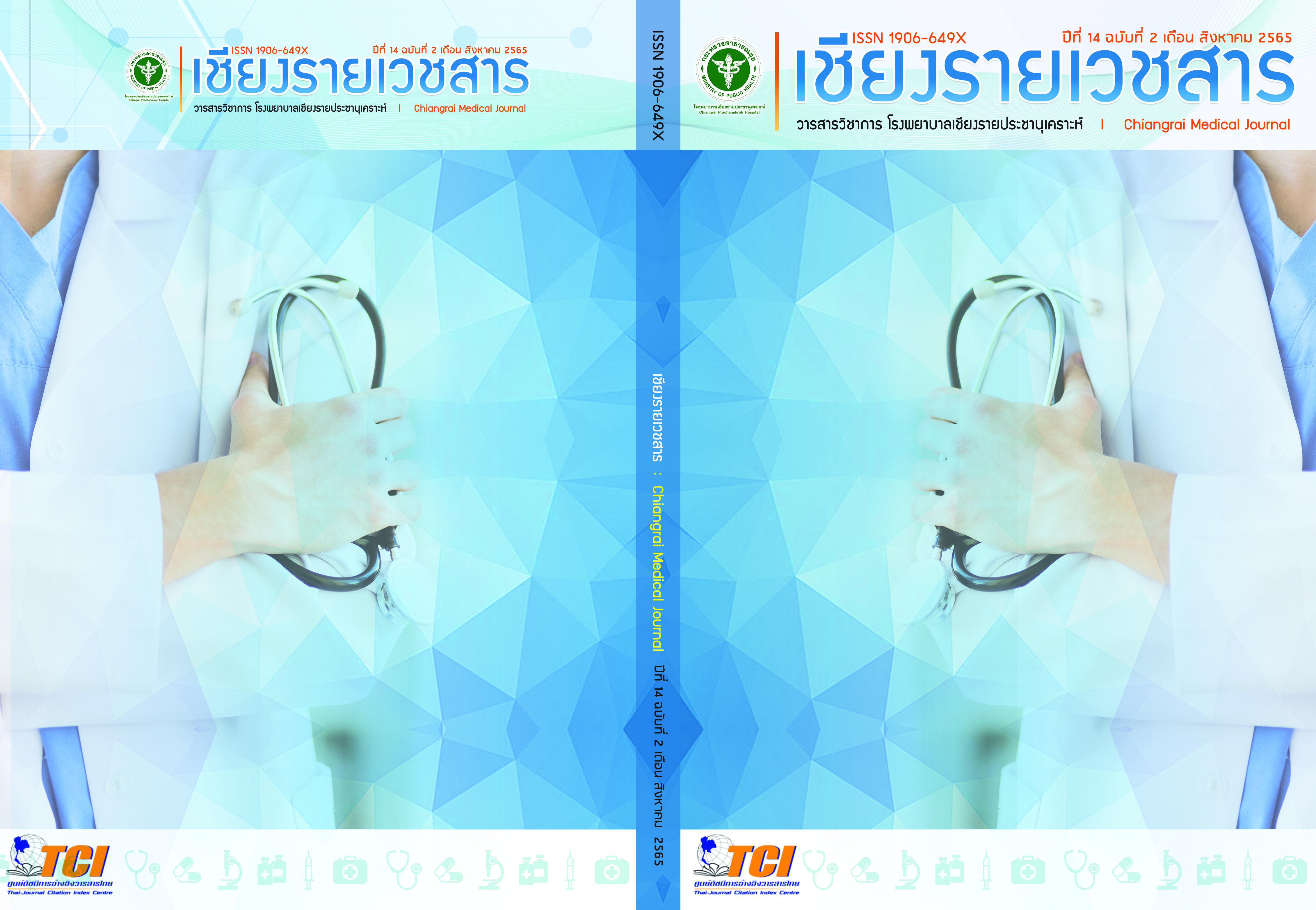ปัจจัยที่มีผลต่อความไม่สำเร็จของการรักษาแบบไม่ผ่าตัด ในผู้ป่วยโรคลำไส้กลืนกัน โรงพยาบาลเชียงรายประชานุเคราะห์
Main Article Content
บทคัดย่อ
ความเป็นมา: โรคลำไส้กลืนกันเป็นสาเหตุของภาวะลำไส้อุดตันที่พบได้บ่อยในเด็กเล็ก ในปัจจุบันวิธีรักษาโรคลำไส้กลืนกันโดยวิธีไม่ผ่าตัดถือเป็นมาตรฐานการรักษา ซึ่งทำได้โดยการสวนลมหรือน้ำ อัตราความสำเร็จของการรักษาโดยวิธีไม่ผ่าตัดขึ้นอยู่กับหลายปัจจัย อัตราความสำเร็จของการรักษาในปัจจุบันโดยทั่วไปอยู่ที่ร้อยละ 85 แต่ความสำเร็จของโรงพยาบาลเชียงรายประชานุเคราะห์ทำได้เพียงร้อยละ 66 เท่านั้น
วัตถุประสงค์: ศึกษาปัจจัยที่มีผลต่อความไม่สำเร็จของการรักษาโรคลำไส้กลืนกันโดยวิธีไม่ผ่าตัด ในโรงพยาบาลเชียงรายประชานุเคราะห์
วิธีการศึกษา: งานวิจัยนี้เป็นการศึกษาข้อมูลย้อนหลังจากเวชระเบียนของผู้ป่วยที่เป็นโรคลำไส้กลืนกันที่รักษาในโรงพยาบาลเชียงรายประชานุเคราะห์เป็นระยะเวลา 10 ปี
ผลการศึกษา: จากการเก็บข้อมูล พบมีผู้ป่วยโรคลำไส้กลืนกัน 163 ราย โดยทั้งหมดนี้มารับการรักษาในโรงพยาบาลด้วยโรคลำไส้กลืนกันทั้งหมด 175 ครั้ง และทำการรักษาโดยไม่ผ่าตัด 159 ครั้ง อัตราความสำเร็จของการรักษาอยู่ที่ร้อยละ 66.67 ปัจจัยที่มีผลต่อการรักษาที่ไม่สำเร็จ ได้แก่ การคลำได้ก้อนในท้อง และตำแหน่งลำไส้กลืนกันอยู่ที่ Left colon
สรุปและข้อเสนอแนะ: การคลำได้ก้อนในท้องและตำแหน่งลำไส้กลืนกันอยู่ที่ Left colon เป็นปัจจัยที่ส่งผลต่อความไม่สำเร็จการรักษาแบบไม่ผ่าตัด แต่ถึงแม้จะมีปัจจัยดังกล่าว ถ้าผู้ป่วยไม่มีข้อห้ามในการรักษาแบบไม่ผ่าตัดก็ควรรักษาแบบไม่ผ่าตัดก่อนเสมอ เนื่องจากมีอัตราความสำเร็จที่ค่อนข้างสูง
Article Details

อนุญาตภายใต้เงื่อนไข Creative Commons Attribution-NonCommercial-NoDerivatives 4.0 International License.
เอกสารอ้างอิง
Tiffany NW. Intussusception. In: George WH, Patrick M, Shawn DP, editors. Holcomb and ashcraft’s pediatric surgery. 7th ed. Philadelphia: Elsevier; 2020: p. 621-7.
Paul MC. Intussusception. In: Coran AG, Caldamone AA, Adzick NS, Krummel TM, Laberge JM, Shamberger RC, editors. Pediatric surgery. 7th ed. Philadelphia: Elsevier; 2012: p.1093-110.
Bubphachai P, Tongsin A, Ratanaprakan W, Niramis R. Predictive factors for failure of air enema reduction in childhood intussusception. The Thai Journal of Surgery.2015;36:141-6.
Ariyanukitja S, Sutthiwongsing A. Intussusception pediatric intussusception in pediatric patients at Chiangrai prachanukroh hospital. Chiangrai medical Journal. 2555;4(2): 25-34.
Ondhia MN, Al-Mutawa Y, Harave S, Losty PD. Intussusception: a 14-year experience at a UK tertiary referral centre. J Pediatr Surg. 2020;55(80):1570-3.
Akello VV, Cheung M, Kurigamba G, Semakula D, Healy JM, Grabski D, et al. Pediatric intussusception in Uganda: differences in management and outcomes with high-income countries. J Pediatr Surg. 2020;55(3):530-4.
Goel I, Anand R, Choudhury SR, Agarwal S. Evolving concepts in ultrasonography of pediatric intussusceptions: unequivocal differentiation of ileocolic, obstructive and transient small-bowel intussusceptions. Ultrasound Med Biol. 2020;46(3):589-97.
Khorana J, Singhavejsakul J, Ukarapol N, Laohapensang M, Siriwongmongkol J, Patumanond J. Prognostic indicators for failed nonsurgical reduction of intussusception. Ther Clin Risk Manag. 2016 ;12:1231-7.
Khorana J, Singhavejsakul J, Ukarapol N, Laohapensang M, Wakhanrittee J, Patumanond J. Enema reduction of intussusception: the success rate of hydrostatic and pneumatic reduction. Ther Clin Risk Manag. 2015;11:1837-42.
Lehnert T, Sorge I, Till H, Rolle U. Intussusception in children--clinical presentation, diagnosis and management. Int J Colorectal Dis. 2009;24(10):1187-92.
Blackwood BP, Theodorou CM, Hebal F, Hunter M CJ. Pediatric intussusception: decreased surgical risk with timely transfer to a children's hospital. Pediatr Care (Wilmington). 2016;2(3):18.


